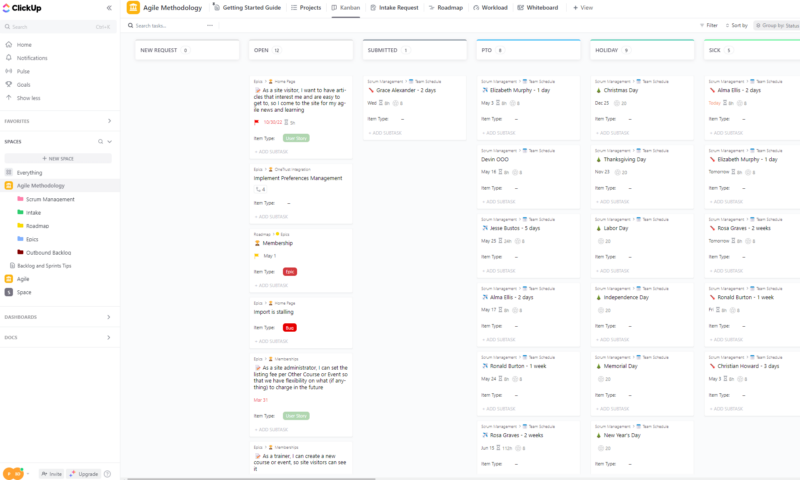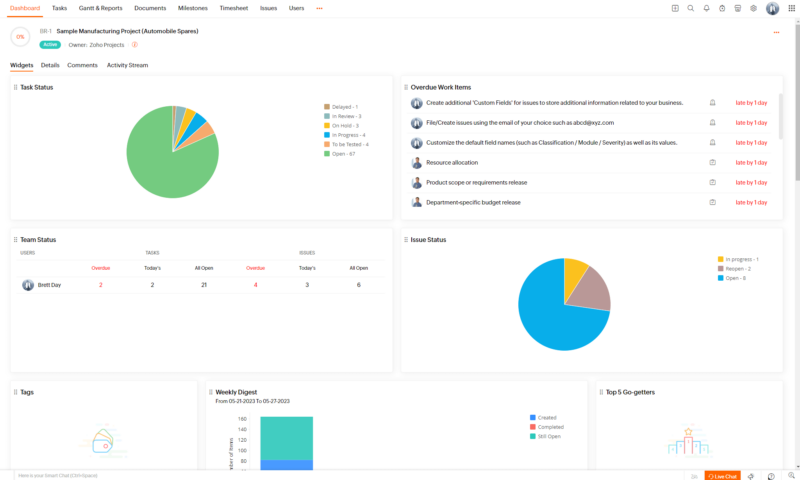If you’re learning about capacity planning, it’s likely you’ve also come across resource planning. You may be wondering what the difference is between the two. To help you understand, we’ve created this capacity planning vs resource planning guide. It explains the key differences and how you can use each process to plan effectively.
Product and project managers have to juggle many moving parts to ensure success. This involves identifying which specialist workers a business needs and how best to utilize them. It also involves sourcing materials to build products and serve customers. Using the best project management software to plan can help ensure you have the necessary resources.
Put simply, resource planning tends to come before capacity planning. However, it may also be a requirement throughout a project life cycle or production cycle. To ensure you approach both capacity planning and resource planning correctly, it’s best to have as much knowledge as possible about both. Let’s get started.
Capacity Planning vs Resource Planning
| Resource Planning | Capacity Planning |
|---|---|
| Which resources do we need to complete a project? | How many projects can we work on? |
| Do we need materials, tools or workers? | How can we best utilize our available resources? |
| Is there an excess of resources we need to reduce? | Which tasks should be allocated based on skill sets and experience? |
| How can we best support the workforce resources we have? | How many products are we able to build to meet demand? |
Resource planning is about assessing your resource requirements. Capacity planning involves resource allocation and ongoing resource management so you get the most out of what you have. We will break down capacity planning vs resource planning separately to give you a more detailed understanding of each one.
What Is Capacity Planning?
Capacity planning follows a specific process and includes different capacity planning strategies. In project management, it starts by assessing your resource availability and then allocating tasks — usually on a kanban board — on the basis of availability, skillset and all-around workload.
The purpose of capacity planning, especially when it relates to the workforce, is to ensure no one is doing too much or too little. Sometimes referred to as “team capacity planning,” it also ensures no one on your team is working on a task that is beyond their capabilities. The goal is to prevent dips in productivity and ensure project completion.

whether workers have too much or too little on their plates.
Capacity planning has a slightly different meaning when it pertains to product management. Though team capacity planning is still required, so is planning for materials and the ability to build a specific number of products for your customers. It can also mean building more products than the actual demand in anticipation of growing customer sales.
We’ll now cover the mindset and expectations needed to approach capacity planning and allocate resources effectively. This section will help you avoid poor capacity planning and help you achieve project success for your company.
Capacity Planning Examples
Though project managers and product managers are often responsible for capacity planning, other departments need it as well. For example, human resources personnel often need to plan when they will have the capacity to onboard new hires and carry out fresh hiring rounds.
Here’s a very basic example of resource capacity planning. Let’s say you work in software development and have three clients. You have to assist each one every day, which amounts to 24 hours of daily work in order to deliver the product on time.
Of course, one software developer alone cannot handle that workload. Therefore, the plan would be to spread the work among three software developers if we consider one working day to last eight hours.
What Is Resource Planning?
Remember that resource planning is not the same as resource capacity planning, which comes after you have looked at the project scope and identified the resources you need. Nor is it only about the type of expertise you need in your workforce. For example, it may also include assessing whether you need resource planning software to complete your tasks.
Think of resource planning for the workforce like this: A financial company needs internal customer software, and they ask your company to build it. The project manager will need to decide who they need to recruit in order to fulfill the project. For example, along with human resources, they will need to hire software developers, a product owner and a scrum master.
Then, they’ll need to assess the tools they need, such as GitHub, which will allow them to code. They’ll also need to decide which software they will need to manage the workload. monday.com and Wrike’s project management software are good options. These are just some of the many considerations to keep in mind during the resource planning process.
Let’s take a look at some of the key characteristics required to implement effective resource planning.
Resource Planning Example
Resource planning is fairly similar to resource capacity planning. For this example, let’s say your company is building a physical product. It’s an interior design company that also builds furniture items. Your resource requirements are a sales manager, a designer and a carpenter, plus all the materials and tools required to build the physical product.
Someone working in resource management will be responsible for identifying all the resources needed so the team can move on to the next phase and carry out the work. They’ll also identify the amount of time it will take to complete the work, allowing the capacity planning team to accurately allocate resources.
Resource and Capacity Planning Best Practices
Capacity planning and resource planning have some best practices in common that will help you plan successfully. For an optimal outcome, stick to the best practices detailed below.
- Analyze potential risks: It’s good to look out for potential risks and roadblocks that may impact both your capacity planning and your resource planning. This includes sickness or a lack of raw materials further down the line. Make a plan for how you will overcome each risk.
- Make your plan accessible: Planning isn’t only for project and product managers — it’s for the whole team. Ensure authorized users can easily access your plan and understand its data. The top project management tools let you share files with multiple users, and some of the best cloud storage services help manage and share files.
- Don’t guesstimate: It’s good to anticipate growth, but there’s a calculated way of doing so. Look at past data or market trends for similar products and increase production on the basis of what you find. Don’t just guess that more demand will arrive; that’s a surefire way of ending up with lots of waste in terms of materials and finances.
Resource Capacity Planning Template
A good resource capacity planning tool will make your work life much easier. Most of the leading software providers also offer templates to help guide you and get started quickly and relatively easily. monday.com has an excellent template for capacity and resource planning. You can learn more about the platform in our monday.com review.

If you prefer to work in spreadsheets, Smartsheet offers a resource capacity planning Excel template that you can use to add and manage your project data. It’s a great tool for all types of project management. Learn more in our Smartsheet review.
Final Thoughts
That brings our capacity planning vs resource planning guide to a close. Remember to follow best practices, and invest in a project management and resource capacity planning tool if possible to help the process run smoothly. In addition, bookmark this article so you can easily refresh your knowledge.
Did you find this guide useful? Are there other areas of project management you would like us to cover? What is your favorite resource capacity planning tool to manage your resource requirements? Let us know in the comments. Thanks for reading.
FAQ: Resource Planning vs Capacity Planning
-
The three most common types of capacity planning are workforce planning, tool planning and product planning.
-
Resource planning is sometimes referred to as resource capacity planning; however, they are not the same and involve a slightly different implementation process.
-
Capacity planning is the process of resource allocation and production management. Capacity management involves monitoring the plan throughout the project and adapting as needed. Some of the roles and responsibilities for each process overlap.
-
Production planning focuses on how a company will build a product, whereas capacity planning focuses on how a company manages its resources.
{“@context”:”https:\/\/schema.org”,”@type”:”FAQPage”,”mainEntity”:[{“@type”:”Question”,”name”:”What Are the Three Types of Capacity Planning?”,”acceptedAnswer”:{“@type”:”Answer”,”text”:”
The three most common types of capacity planning are workforce planning, tool planning and product planning.\n”}},{“@type”:”Question”,”name”:”What Is Another Name for Resource Planning?”,”acceptedAnswer”:{“@type”:”Answer”,”text”:”
Resource planning is sometimes referred to as resource capacity planning; however, they are not the same and involve a slightly different implementation process.\n”}},{“@type”:”Question”,”name”:”What Is the Difference Between Capacity Planning and Management?”,”acceptedAnswer”:{“@type”:”Answer”,”text”:”
Capacity planning is the process of resource allocation and production management. Capacity management involves monitoring the plan throughout the project and adapting as needed. Some of the roles and responsibilities for each process overlap.\n”}},{“@type”:”Question”,”name”:”Is Capacity Planning the Same as Production Planning?”,”acceptedAnswer”:{“@type”:”Answer”,”text”:”
Production planning focuses on how a company will build a product, whereas capacity planning focuses on how a company manages its resources.\n”}}]}
The post Capacity Planning vs Resource Planning: Differences Explained in 2024 appeared first on Cloudwards.


